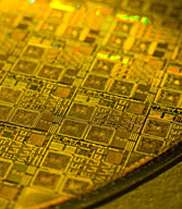Honey, I shrunk the receiver

(�鶹��ԺOrg.com) -- CSIRO and Australian company Sapphicon Semiconductor Pty Ltd have signed an agreement to jointly develop a complete radio receiver on a chip measuring just 5 mm x 5 mm that could eventually be used in mobile phones and other communications technologies.
The development of a low-cost, ultra-high-bandwidth ‘system-on-chip’ device could also replace traditional receivers currently used in radio astronomy applications, many of which are about the size of a bar fridge.
The chip’s first test will be in CSIRO’s Australian SKA Pathfinder (ASKAP) - an array of 36 radio dishes that acts as a single telescope now under construction in Western Australia.
It will be trialled in an innovative radio camera (or “phased array feed”) developed by CSIRO, which sits at the focal centre of each ASKAP dish to receive incoming cosmic radio waves.
“This chip will minimise the size and weight of the phased array feed, reduce cost and power, and facilitate maintenance,” said CSIRO Project Director for ASKAP, Dr David DeBoer.
“In our radio camera, it could revolutionise radio astronomy.”
Sapphicon Semiconductor’s CEO, Andrew Brawley, said the chip will be developed using the company’s Silicon-on-Sapphire CMOS process.
“A sapphire substrate is not ‘lossy’,” Mr Brawley said. “That’s important for an application such as radio astronomy, because it minimises losses in integrated passive components, significantly improving their performance.
“Perhaps the biggest advantage is that so much circuitry - RF, logic, mixed-signal and passives - can be incorporated into the same chip. This is real miniaturisation and could open up whole new product markets,” Mr Brawley said.
The chip is very high bandwidth, able to sample about 600 MHz around a central frequency of 1400 MHz.
International researchers developing the Square Kilometre Array radio telescope are interested in the R&D proposed by CSIRO and Sapphicon. No other group is developing a fully integrated single-chip receiver.
“This sort of technology, which looks to deliver mass-produced components on low-loss substrates consuming little power, is ideal for the SKA, which potentially needs millions of highly sensitive electronic sensors,” said Professor Richard Schilizzi, Director of the SKA Program Development Office in the UK, which coordinates international planning for the SKA.
“CSIRO is to be congratulated on this important step.”
The development project will take about two years to complete and will involve a number of stages of sub-component development and testing.
CSIRO will contribute the intellectual property it has generated over the last five years from research funded by the Commonwealth Government under the second round of the Major National Research Facilities program in 2001.
CSIRO’s SKA Director, Professor Brian Boyle, said that that research led to a proof-of-concept implemented in RF-CMOS. “It’s a good demonstration of the value of long-range investment in these technologies,” he said.
Following its collaboration with Sapphicon and CSIRO on earlier proof-of-concept projects, the Centre for Technology Infusion at La Trobe University in Melbourne will also work with Sapphicon in the development of the novel chip.
CSIRO’s Business Development Manager for ASKAP, Dr Carole Jackson, said the development of these devices will require significant Australian electronics design expertise.
“It will encourage training and the diffusion of expertise throughout this industry.”
Provided by CSIRO



















